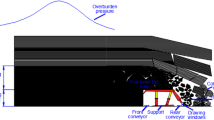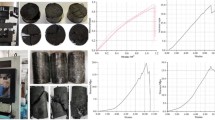Abstract
Despite numerous empirical, numerical, and hybrid studies conducted on the subject of coal rib failure, mine fatalities related to rib failures continue to occur at around 1.5 per year between 2009 and 2021. To date, a standard methodology for the design of coal rib supports that can accommodate the wide range of unique conditions found in coal mines in the USA has not been developed, forcing mine operators to rely on the trial-and-error process or industrial legacy practices for the design of coal rib support patterns. In this study, to better understand the support systems’ effectiveness, various rib bolting scenarios were investigated. A coal mass constitutive model is implemented to a distinct element method (DEM) code, and rib factor-of-safety (RibFOS) analyses were performed by applying strength-reduction for the coal matrix and explicitly modeled face cleats. Ribs with various overburden depths and mining heights composed of solid Banded-Bright coal (BBC) were considered in this study. Different scenarios such as rib bolt length and the number of bolts were studied to quantify the effect of primary rib support density on rib stability. As a result of the unsupported coal rib analyses, a decaying exponential relationship is proposed between the mining height-overburden depth and the RibFOS. The developed coal rib models clearly show the coal-rib bolt interaction and illustrate how the addition of rib bolts restricts the movement of the coal rib. The results reveal that the strength reduction method in DEM code with the coal-mass model can aid in the development of practical primary support charts, which can help in the rib support design process. In addition, an unsupported RibFOS cutoff is proposed, beyond which the addition of primary support cannot stabilize the failed rib structure.









Similar content being viewed by others
Data Availability
The data that support the findings of this study are available from the corresponding author upon reasonable request.
References
Mark C (2023) The road to zero: the fifty-year effort to eliminate roof fall fatalities from US underground coal mines. In: Proceedings of the 42nd international conference on ground control in mining, p 1–28
Mine safety and health administration (MSHA) (2021) Fatality Reports. Retrieved June 22, 202, from https://bit.ly/2UMd0iE
Mohamed KM, Murphy MM, Lawson HE, Klemetti T (2016a) Analysis of the current rib support practices and techniques in U.S. coal mines. Int J Min Sci Technol 26(1):77–87
Shepherd J (2002) Assessment of rib instability hazards for strata management systems. In: Coal Operators’ Conference, University of Wollongong & the Australasian Institute of Mining and Metallurgy, vol 2002, pp 122–125
Heritage Y (2018) Mechanics of rib deformation at Moranbah North mine – a case study. In: Proceedings of the 18th Coal Operators’ Conference. Mining Engineering, University of Wollongong, p 58–71
Heritage Y (2019) Mechanics of rib deformation – observations and monitoring in Australian coal mines. Int J Min Sci Technol 29(1):119–129
Guner D, Nowak S, Sunkpal M, Sherizadeh T, Mohamed K, Xue Y (2023) Review of Current Coal Rib Control Practices. Undergr Space 9:53–75
Shen B (2014) Coal mine roadway stability in soft rock: a case study. Rock Mech Rock Eng 47(6):2225–2238
Yao Q, Li X, Sun B, Ju M, Chen T, Zhou J et al (2017) Numerical investigation of the effects of coal seam dip angle on coal wall stability. Int J Rock Mech Min Sci 100:298–309
Sinha S, Walton G (2021) Modeling the behavior of a coal pillar rib using Bonded Block Models with emphasis on ground-support interaction. Int J Rock Mech Min Sci 148:104965
Sunkpal M, Sherizadeh T (2021) Exploring the deformation mechanics of coal ribs using the distinct element modeling approach. Rock Mech Rock Eng 55:2879–2898
Vakili A, Hebblewhite BK (2010) A new cavability assessment criterion for longwall top coal caving. Int J Rock Mech Min Sci 47(8):1317–1329
Bai QS, Tu SH, Zhang C, Zhu D (2016) Discrete element modeling of progressive failure in a wide coal roadway from water-rich roofs. Int J Coal Geol 167:215–229
Esterhuizen GS (2012) A stability factor for supported mine entries based on numerical model analysis. In: Proceedings of the 31st international conference on ground control in mining, vol 7, pp 1–9
Tulu IB, Esterhuizen GS, Klemetti T, Murphy MM, Sumner J, Sloan M (2016) A case study of multi-seam coal mine entry stability analysis with strength reduction method. Int J Min Sci Technol 26(2):193–198
Bahrani N, Hadjigeorgiou J (2018) Influence of stope excavation of drift convergence and support behavior: insights from 3D continuum and discontinuum models. Rock Mech Rock Eng 51(8):2395–2413
Sinha S, Walton G (2019) Understanding continuum and discontinuum models of rock-support interaction for excavations undergoing stress-induced spalling. Int J Rock Mech Min Sci 123:104089
Itasca Consulting Group, Inc., (2021) 3DEC Ver. 7.0. Minneapolis, U.S
Mohamed K, Rashed G, Sears M, Rusnak J, Van Dyke M (2018) Calibration of coal-mass model using in-situ coal pillar strength study. In: Proceedings 91st annual meeting of the SME-MN section Minneapolis
Rusnak J (2017) Coal strength variation by lithotype for high-volatile a bituminous coal in the Central Appalachian Basin. In: Proceedings of the 36th International Conference on Ground Control in Mining. West Virginia University, Morgantown, WV, p 198–207
Mohamed KM, Cheng Z, Rashed G (2019) Coal rib stability based on the strength reduction of the coal mass model. In: 53rd US Rock Mechanics/Geomechanics Symposium
Hoek E, Carranza-Torres C, Corkum B (2002) Hoek-Brown failure criterion-2002 edition. Proceedings of NARMS-Tac 1(1):267–273
Fang Z, Harrison JP (2002) Application of a local degradation model to the analysis of brittle fracture of laboratory-scale rock specimens under triaxial conditions. Int J Rock Mech Min Sci 4(39):459–476
Alejano LR, Alonso E (2005) Considerations of the dilatancy angle in rocks and rock masses. Int J Rock Mech Min Sci 42(4):481–507. https://doi.org/10.1016/j.ijrmms.2005.01.003
Mohamed KM, Tulu IB, Klemetti T (2015) Numerical simulation of deformation and failure process of coal-mass. In: Proceedings of the 49th U.S. Rock Mechanics/Geomechanics Symposium, San Francisco, CA, USA, 28 June–1 July 2015; Available online: https://www.onepetro.org/conference-paper/ARMA-2015-363
Mohamed KM (2022) Personal communication
Xue Y, Mohamed KM (2021) Stability analysis of coal rib with rock parting based on the strength reduction of the coal mass model. In: 55th US Rock Mechanics/Geomechanics Symposium. OnePetro
Zienkiewicz OC, Humpheson C, Lewis RW (1975) Associated and non-associated visco-plasticity and plasticity in soil mechanics. Geotech 25(4):671–689
Mohamed K, Kimutis R, Xue Y, Rasheed G (2020) Rib support optimization for a room-and-pillar mine. In: Proceedings of the 39th international conference on ground control in mining, p 247–256
Seedsman R (2021) Rib scaling and the stability of coal pillars. Min Technol 131:38–50
Liu H, Sang S, Xue J, Wang G, Xu H, Ren B, Liu C, Liu S (2016) Characteristics of an in situ stress field and its control on coal fractures and coal permeability in the Gucheng block, southern Qinshui Basin, China. J Nat Gas Sci Eng 36:1130–1139. https://doi.org/10.1016/j.jngse.2016.03.024
Esterhuizen, G.S., 2017. Personal communication.
Zipf K (2006) Numerical modeling procedures for practical coal mine design. In: 41st U.S. Symposium on Rock Mechanics (ARMA)
Stone R (2016) Design of primary ground support during roadway development using empirical databases. Int J Min Sci Technol 26(1):131–137
Disclaimer
The views, opinions, and recommendations expressed herein are solely those of the authors and do not imply any endorsement by the ALPHA FOUNDATION, its Directors, and staff.
Funding
This study was sponsored by the Alpha Foundation for the Improvement of Mine Safety and Health, Inc. (ALPHA FOUNDATION).
Author information
Authors and Affiliations
Corresponding author
Additional information
Publisher’s Note
Springer Nature remains neutral with regard to jurisdictional claims in published maps and institutional affiliations.
Rights and permissions
Springer Nature or its licensor (e.g. a society or other partner) holds exclusive rights to this article under a publishing agreement with the author(s) or other rightsholder(s); author self-archiving of the accepted manuscript version of this article is solely governed by the terms of such publishing agreement and applicable law.
About this article
Cite this article
Guner, D., Sherizadeh, T., Nowak, S. et al. Distinct Element Analysis for the Effectiveness of Preliminary Coal Pillar Rib Support Systems Based on the Strength Reduction Method Using Coal Mass Constitutive Model. Mining, Metallurgy & Exploration 40, 1535–1546 (2023). https://doi.org/10.1007/s42461-023-00815-0
Received:
Accepted:
Published:
Issue Date:
DOI: https://doi.org/10.1007/s42461-023-00815-0




